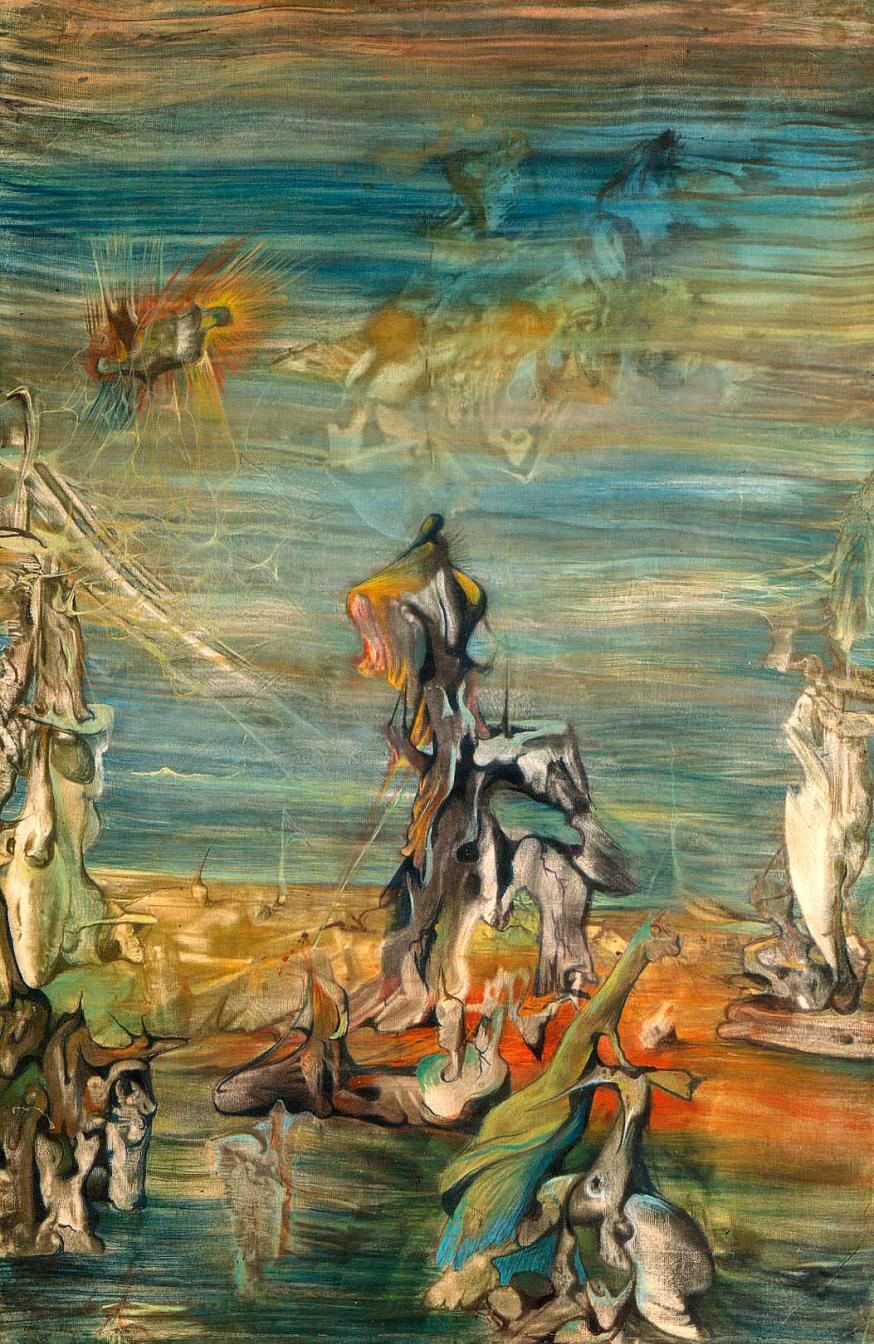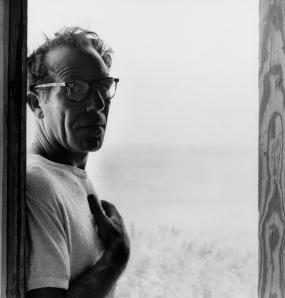Boris Margo
1902–1995


Boris Margo, 1952; Photographer Arnold Newman
All artworks displayed above are currently available. To inquire about additional works available by this artist, please contact the gallery.
Biography
...The art of our time must embody new content as well as new form and new technique. With these three elements present, one can express... all the agony, joy and hope of our age.
Boris Margo is known for his haunting, surrealist canvases and graphically innovative, luminous abstractions that explored the subconscious realm. An individualist among the generation of artists who matured just after the first great wave of international modernism, Margo is distinguished by his unfettered imagination and extraordinary capacity for material experimentation.
Born and raised in Volochisk, a Ukrainian town on the border of Austria and Russia, Boris Margo (1902–1995) studied at the Polytechnik of Art in Odessa from 1918 to 1923. The following year, with the help of grants, he participated in Futemas (Workshop for the Art of the Future) in Moscow and in 1927, studied with cubist/surrealist painter Pavel Filinov, at the Analytical School of Art in Leningrad (now St. Petersburg). In 1928, the Soviet government granted Margo permission to study abroad, and he traveled to North America, living in Montreal, Canada, where he worked as a muralist for a year before immigrating to the United States in 1930. Margo made New York City his home, and in 1940, he also began spending summers in a tiny cottage in Provincetown, Massachusetts.
The pull that surrealism had on Margo in Europe strengthened in the United States, where the style was gaining momentum, thanks to an influx of artists fleeing the rising tide of European fascism. In New York, Margo worked as an assistant to Arshile Gorky, and he befriended a circle of artists that included Mark Rothko, with whom Margo shared an apartment in the 1940s. Too poor to afford painting materials, Margo innovated with “decalomania,” a process in which he used automatism to select and assemble fragments of print and images from magazines. As Bernard Smith has noted, surrealists were preoccupied with discovering “technical devices for tapping into the unconscious,”[1] and decalomania soon became a favorite of theirs, most famously in the work of Max Ernst.
Margo’s material deprivation led him to experiment with other processes as well, and he is perhaps most celebrated for developing the cellocut, a form of printmaking that became popular in the 1960s, decades after Margo’s innovation. The technique involved dissolving sheet celluloid in acetone to create a viscous liquid that Margo would pour onto a smooth surface like Masonite, wood, or metal in order to create a raised surface. The thicker the solution, the heavier the surface would become. Once the celluloid solidified, Margo could alter the surface with standard etching and woodcut tools or use acetone to break down areas of the hardened celluloid. The etched plates could then be run through a press or printed by hand.[2] Typically, Margo would “line up variously colored inks onto a plate, apply a roller to the colors to mix them, ink the cellocut with the blended pigments, and print the now multicolored plate in a single run through the press.”[3] The result was a fluid composition that “well served Margo’s brand of surrealism: a futuristic universe, inhabited by strange biological and architectural forms.”[4] In 1942, the Metropolitan Museum of Art purchased the cellocut Floating Objects Illuminated; in 1945, the Brooklyn Museum also acquired a cellocut; and in 1946, the Philadelphia Print Club awarded him a Mildred Boericke Purchase Prize for one of his cellocut prints.
In the late 1940s, Margo arrived at his mature style—“a semi-abstract blending of shapes and atmospheric spaces notable for intricacy and warm flushes of color,”[5] —and his career steadily rose. In 1947, Margo joined the Betty Parsons Gallery, New York and participated in the group exhibition The Ideograph Picture, which also included work by Hans Hofmann, Mark Rothko, Ad Reinhardt, Clyfford Still, and Theodoros Stamos. While Margo’s work encompassed biomorphism in the 1940s and calligraphy in the 1950s, his debt to surrealism remained apparent in both his visual style and his conception of art. In 1946, Margo was a visiting artist at American University in Washington, DC; he spent two years as a visiting professor at the School of the Art Institute of Chicago (1957-1959); and he was invited to be a visiting artist and/or professor at several other prestigious institutions. Even after his financial status improved and he was able to paint more often, Margo continued to make cellocuts, for which he received acclaim, winning purchase prizes from the Brooklyn Museum of Art in 1947, 1953, 1955, 1960, and 1964. In 1968, Margo suffered a stroke that incapacitated him, but he continued to exhibit his work internationally, in group and solo shows, until his death in Hyannis, Massachusetts in 1995.
The first retrospective of Margo’s work was in 1962, organized by the Tweed Gallery at the University of Minnesota, Duluth, which traveled to the Columbia Museum of Art in Columbia, SC, Telfair Academy of Arts and Sciences in Savannah, GA, Columbus Museum of Arts and Crafts in Columbus, GA, Fort Lauderdale Museum of the Arts in Ft. Lauderdale, FL, and Norton Gallery School of Art, West Palm Beach, FL. In 1988, the same year that Margo received a Pollock-Krasner Foundation grant, the Provincetown Art Association and Museum in Provincetown, MA organized his largest retrospective to date, which traveled to the Museum of Fine Arts, St. Petersburg, FL, and produced a catalogue with original scholarship.
Michael Rosenfeld Gallery has represented Boris Margo and his estate since 1992 and championed his work in three solo exhibitions: Boris Margo: Surrealism to Abstraction, 1932-1952 in 1992; Borris Margo: Fantasy in Form in 1995, and Boris Margo: Divine Light, 1950-1952 in 1998. Since his death, Margo’s work has been included in numerous museum exhibitions around the world, including Singular Impressions: The Monotype in America at National Museum of American Art, Smithsonian Institution, Washington, DC (1997); The Surrealists in Exile and the Origin of the New York School at Museo Nacional Centro de Arte Reina Sofia, Madrid, Spain and Musées de Strasbourg, Strasbourg (1999); Surrealism USA, National Academy of Design, New York, NY and Phoenix Art Museum, Phoenix, AZ (2005); The Pull of Experiment: Postwar American Printmaking at Yale University Art Gallery, New Haven, CT; Monotypes: Painterly Prints at The Cleveland Museum of Art, Cleveland, OH (2015); Edge of Visibility, curated by Susan Tallman in partnership with Art in Print, International Print Center New York, New York, NY (2018); Atelier 17 and Modern Printmaking in the Americas at Museu de Arte Contemporânea da Universidade de São Paulo, São Paulo, Brazil (2019); and Surrealism in American Art at Centre de la Vielle Charité, Marseille, France (2021).
Works by Boris Margo can be found in museum collections around the world, including Addison Gallery of American Art, Phillips Academy, Andover, MA; Albright-Knox Gallery, Buffalo, NY; Art Institute of Chicago, Chicago, IL; Baltimore Museum of Art, Baltimore, MD; The Brooklyn Museum, Brooklyn, NY; Cincinnati Art Museum, Cincinnati, OH; Corcoran Gallery of Art, Washington, DC; Cornell University, Ithaca, NY; Delaware Art Museum, Wilmington, DE; Georgia Museum of Art, University of Georgia, Athens, GA; Hammer Museum, Los Angeles, CA; Harvard University Art Museums, Cambridge, MA; Honolulu Academy of Arts, Honolulu, HI; The Jewish Museum, New York, NY; Joslyn Museum of Art, Omaha, NB; Kalamazoo Institute of Arts, Kalamazoo, MI; Los Angeles County Museum, Los Angeles, CA; The Metropolitan Museum of Art, New York, NY; Moderna Museet, Stockholm, Sweden; Museu de Arte Contemporânea da Universidade de São Paulo (MAC USP), São Paulo, Brazil; Museum of Modern Art, New York, NY; Museum of Contemporary Art, University of São Paulo, São Paulo, Brazil; National Museum of American Art, Washington, DC; New Orleans Museum of Art, New Orleans, LA; New York Public Library, New York, NY; Philadelphia Museum of Art, Philadelphia, PA; Portland Art Museum, Portland, OR; Rhode Island School of Design, Providence, RI; The John and Marble Ringling Museum of Art, Sarasota, FL; National Gallery of Art, Washington, DC; San Francisco Museum of Art, San Francisco, CA; Sao Paulo Museum of Art, Sao Paulo, Brazil; Tweed Gallery, University of Minnesota, Deluth, MN; Whitney Museum of American Art, New York, NY; and Yale University Art Gallery, New Haven, CT
Michael Rosenfeld Gallery LLC is the exclusive representative of the Estate of Boris Margo.
[1] Bernard Smith, Modernism’s History: A Study in Twentieth-Century Art and Ideas (New South Wales: UNSW Press, 1998), 132.
[2] John Ross, Claire Romano and Tim Ross, The Complete Printmaker: Techniques/Traditions/Innovations (New York: Simon and Schuster, 1991), 51.
[3] “Boris Margo,” Prints without Pressure, the New York Public Library, http://legacy.www.nypl.org/research/chss/spe/art/print/exhibits/pressure/artists2.html (accessed April 2010)
[4] “Boris Margo,” Prints without Pressure, the New York Public Library, http://legacy.www.nypl.org/research/chss/spe/art/print/exhibits/pressure/artists2.html (accessed April 2010)
[5] Roberta Smith, “Boris Margo, Surrealist, 92, And Inventor,” New York Times July 13, 1995, http://www.nytimes.com/1995/07/13/obituaries/boris-margo-surrealist-92-and-inventor.html (accessed April 2010).
Gallery Exhibitions
Press
Publications

